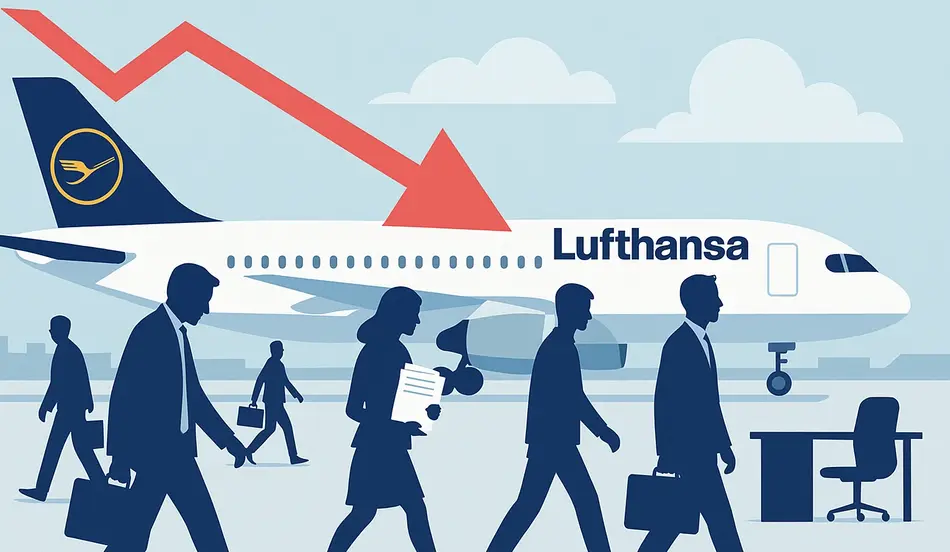Lufthansa plans to cut 4,000 administrative jobs by 2030 as Europe’s largest aviation group embarks on a comprehensive restructuring effort to address what it describes as an overly complicated and bloated organizational structure. The announcement, made during the company’s Capital Markets Day in Munich, represents the first comprehensive update on long-term goals in several years and signals a significant shift toward automation and artificial intelligence to improve operational efficiency.
The job cuts, which will be implemented gradually over several years rather than as immediate layoffs, are part of Lufthansa’s broader strategy to streamline operations and reduce costs. The company has struggled to meet its cost base targets, prompting this aggressive approach to organizational simplification through automation and process improvements.
The restructuring comes at a critical time for Lufthansa, which faces ongoing challenges including potential pilot strikes, fleet renewal delays, and the need to improve its adjusted operating margin to 8-10% by 2030. The company’s decision to focus on administrative positions rather than operational roles reflects a strategic approach to reducing overhead while maintaining core aviation services.
This announcement represents a significant development in the aviation industry’s ongoing transformation, as airlines worldwide grapple with the need to modernize operations while managing costs and improving profitability. Lufthansa’s approach may serve as a model for other carriers facing similar challenges.
The Strategic Rationale: Simplifying a Bloated Organization
Lufthansa’s decision to cut 4,000 administrative jobs stems from a fundamental assessment that the company has become “too complicated” and “too bloated” in its organizational structure. This self-critical analysis reflects the airline’s recognition that bureaucratic inefficiencies are hindering its ability to compete effectively in an increasingly challenging aviation market.
The company’s cost base struggles have been a persistent challenge, with Lufthansa failing to meet its targets despite various cost-cutting measures implemented in recent years. The administrative job cuts represent a more aggressive approach to addressing these structural issues, focusing on reducing overhead rather than cutting core operational capabilities.
The gradual implementation timeline, extending to 2030, suggests that Lufthansa is taking a measured approach to workforce reduction, allowing for natural attrition and retraining opportunities rather than immediate mass layoffs. This approach may help minimize disruption to operations while achieving the desired cost savings.
The focus on administrative positions rather than operational roles indicates that Lufthansa recognizes the importance of maintaining its core aviation services while streamlining support functions. This strategic distinction suggests that the company is prioritizing customer-facing operations while reducing back-office complexity.
The restructuring is part of a broader effort to improve the company’s adjusted operating margin to 8-10% by 2030, a target that requires significant cost reductions and operational improvements. The administrative job cuts are one component of this comprehensive strategy to improve profitability and competitiveness.
The Role of Automation and AI in Workforce Reduction
Lufthansa’s job cuts are closely tied to the company’s increased use of artificial intelligence and automation to improve operational efficiency. The airline industry is increasingly looking to AI to streamline processes, reduce manual work, and improve decision-making across various functions.
The company’s focus on automation reflects broader trends in the aviation industry, where airlines are seeking to reduce labor-intensive processes while maintaining service quality. AI applications in areas such as customer service, scheduling, and maintenance can help reduce the need for administrative staff while improving operational efficiency.
Lufthansa’s approach to AI implementation appears to be focused on improving processes rather than replacing customer-facing staff. The company recognizes that many airline operations, particularly those involving cabin crew, ground operations, and airfield activities, remain highly labor-intensive and cannot be easily automated.
The gradual timeline for job cuts suggests that Lufthansa is planning to implement AI and automation solutions over several years, allowing for a smooth transition and retraining of affected employees. This approach may help minimize resistance to change while achieving the desired efficiency gains.
The company’s emphasis on AI as a key driver of efficiency improvements reflects the aviation industry’s broader recognition that technology can help address cost pressures while maintaining service quality. However, the extent to which AI can replace human workers in administrative functions remains to be seen.
AI and the Future of Work
Lufthansa’s restructuring shows how AI and automation are reshaping industries, driving efficiency but reducing certain roles. Employers can lead this transition by hiring adaptable talent ready to integrate human creativity with technological progress. Post your job on WhatJobs today and connect with professionals prepared to thrive in an AI-driven economy.
Post a Job Free for 30 Days →The Fleet Renewal Challenge: Delays and Opportunities
Lufthansa’s job cuts announcement comes against the backdrop of ongoing challenges with fleet renewal, particularly the delayed delivery of Boeing 787 Dreamliner aircraft. The company has several new aircraft parked in the U.S. awaiting certification for their seats, which has slowed the fleet modernization process.
The fleet renewal delays have had significant implications for Lufthansa’s operations, as new aircraft typically offer better fuel efficiency, lower maintenance costs, and improved passenger experience. The inability to deploy these aircraft has hindered the company’s ability to improve its cost base and operational efficiency.
The administrative job cuts may help offset some of the costs associated with fleet renewal delays, providing additional resources for the company’s modernization efforts. However, the long-term success of the restructuring will depend on the company’s ability to successfully integrate new aircraft into its operations.
The fleet renewal challenge highlights the complexity of Lufthansa’s operational environment, where multiple factors must be managed simultaneously to achieve desired outcomes. The job cuts are just one component of a broader strategy to address these challenges.
The company’s focus on fleet renewal as a key theme for its Capital Markets Day suggests that this remains a priority despite the delays. The administrative job cuts may provide additional flexibility to address these operational challenges.
The Labor Relations Context: Strikes and Workforce Tensions
Lufthansa’s job cuts announcement comes at a time of heightened labor tensions, with pilots threatening to strike and potentially disrupting operations. The company’s focus on reducing administrative costs may be seen as an attempt to address cost pressures while avoiding cuts to operational staff.
The potential pilot strike represents a significant risk to Lufthansa’s operations, as grounded aircraft would negate any cost savings from administrative job cuts. The company’s ability to manage labor relations while implementing workforce reductions will be crucial to the success of its restructuring efforts.
The administrative job cuts may be seen as a way to address cost pressures without directly affecting pilots and other operational staff, potentially reducing the likelihood of labor disputes. However, the broader workforce reduction may still create tensions with labor unions.
The company’s approach to workforce reduction will need to balance cost-cutting objectives with the need to maintain good labor relations. The gradual timeline for job cuts may help minimize labor resistance while achieving the desired cost savings.
The labor relations context highlights the complexity of implementing workforce reductions in a unionized environment, where any changes to employment terms must be carefully managed to avoid industrial action.
The Financial Targets: Margin Improvement and Cash Goals
Lufthansa’s job cuts are part of a broader effort to improve the company’s financial performance, with targets including an adjusted operating margin of 8-10% by 2030 and maintaining the current dividend policy. The administrative workforce reduction is expected to contribute significantly to achieving these targets.
The company’s focus on margin improvement reflects the aviation industry’s ongoing challenges with profitability, particularly in the face of rising fuel costs, increased competition, and changing passenger demands. Administrative job cuts represent one way to address these challenges while maintaining operational capabilities.
The cash goals mentioned in the company’s announcement suggest that Lufthansa is also focused on improving its financial flexibility, which may be important for future investments in fleet renewal and other strategic initiatives. The administrative job cuts may help free up resources for these investments.
The company’s commitment to maintaining its dividend policy suggests that it is balancing the need for cost reduction with the expectations of shareholders. The administrative job cuts may help achieve this balance by reducing costs without significantly impacting revenue-generating operations.
The financial targets highlight the importance of the administrative job cuts to Lufthansa’s overall strategy, as the company seeks to improve its competitive position while maintaining financial stability.
Frequently Asked Questions
Lufthansa plans to cut 4,000 administrative jobs by 2030 – why is this happening?
Lufthansa plans to cut 4,000 administrative jobs by 2030 because the company has become “too complicated” and “too bloated,” struggling to meet cost base targets and needing to improve its adjusted operating margin to 8-10% through automation and process improvements.
How will Lufthansa implement these job cuts?
Lufthansa will implement the job cuts gradually over several years until 2030, focusing on administrative positions rather than operational roles, with the cuts tied to increased automation and AI implementation to improve efficiency.
What role does AI play in Lufthansa’s job reduction strategy?
AI plays a central role in Lufthansa’s job reduction strategy, as the company plans to use artificial intelligence and automation to streamline processes, reduce manual work, and improve operational efficiency, particularly in administrative functions.
How do these job cuts relate to Lufthansa’s fleet renewal challenges?
The job cuts help offset costs associated with fleet renewal delays, particularly with Boeing 787 Dreamliner aircraft parked in the U.S. awaiting seat certification, while providing additional resources for the company’s modernization efforts.
What are Lufthansa’s financial targets driving these job cuts?
Lufthansa aims to achieve an adjusted operating margin of 8-10% by 2030, maintain its dividend policy, and improve cash flow, with administrative job cuts being a key component of this cost reduction strategy.
How do these job cuts fit into broader aviation industry trends?
These job cuts reflect broader aviation industry trends toward efficiency, automation, and cost reduction, as airlines worldwide seek to improve profitability through technology and process improvements while maintaining operational capabilities.
A Real-World Example: The Administrative Worker’s Perspective
Maria Schmidt, a 12-year veteran of Lufthansa’s administrative department in Frankfurt, faces an uncertain future as the company prepares for significant workforce reductions. “I’ve dedicated my career to supporting the airline’s operations,” she explains. “Now I’m being told that my role might be replaced by AI and automation.”
Maria’s situation exemplifies the human cost of Lufthansa’s restructuring efforts. As a senior administrative coordinator who manages flight scheduling and crew assignments, she represents exactly the type of worker targeted by the company’s job reduction strategy.
“I understand that the company needs to be more efficient,” Maria says. “But it’s difficult to see how AI can replace the human judgment and experience that goes into managing complex scheduling operations. There’s so much nuance and problem-solving involved in what we do.”
The uncertainty has created significant anxiety among Maria and her colleagues. “We’re all wondering if we’ll still have jobs in five years,” she explains. “The company says the cuts will be gradual, but that doesn’t make it any easier to plan for the future or provide for our families.”
Maria’s work has already been affected by the company’s focus on automation. “We’re being asked to document all our processes so they can be automated,” she says. “It feels like we’re training our own replacements. But at the same time, we’re being told that our expertise is valuable and needed.”
The prospect of job cuts has created a difficult work environment. “Morale is low,” Maria explains. “People are looking for other opportunities, and those who stay are worried about their future. It’s hard to stay motivated when you don’t know if your job will exist in a few years.”
Maria’s advice to other administrative workers reflects the lessons she’s learned. “Don’t wait for the company to tell you what to do,” she says. “Start learning new skills, especially in technology and data analysis. The future belongs to those who can work with AI, not those who are replaced by it.”
Maria’s story demonstrates that Lufthansa’s job cuts have real human costs that extend far beyond the numbers. The loss of experienced administrative workers like Maria represents a significant loss of institutional knowledge and expertise that may be difficult to replace.
Don’t Let Automation Leave You Behind
Lufthansa’s plan to cut 4,000 administrative jobs by 2030 represents a significant shift in how the aviation industry approaches workforce management and operational efficiency. The company’s focus on automation and AI reflects broader trends that are reshaping the job market across industries.
The key to navigating this changing landscape is to recognize that technology is not just replacing jobs – it’s transforming them. Workers who can adapt to new technologies and develop skills that complement AI and automation will be better positioned for success in the future.
For administrative workers facing potential job cuts, the solution is to embrace change rather than resist it. This means learning new skills, understanding how technology can enhance rather than replace human capabilities, and positioning themselves as valuable contributors to digital transformation efforts.
The broader lesson for all workers is that the future belongs to those who can work alongside technology rather than those who are replaced by it. This requires continuous learning, adaptability, and a willingness to embrace change.
The aviation industry’s transformation is just beginning, and the companies and workers that can successfully navigate this change will be better positioned for long-term success.




